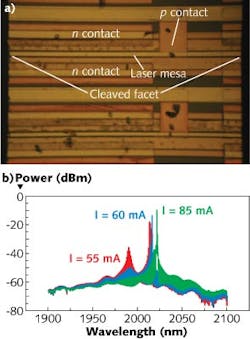INTEGRATED PHOTONICS: GaSb/SOI PICs target integrated SWIR spectroscopy

Spectrometers based on broadband sources, detectors, and dispersive components are too bulky for small-footprint, low-power applications such as portable gas sensing and implantable blood-glucose monitors. But recent progress on integrating gallium antimonide (GaSb) lasers and photodetectors on a silicon-on-insulator (SOI)-based photonic integrated circuit (PIC) platform using CMOS fabrication technology is moving researchers from Ghent University (UGent; Ghent, Belgium) and Université Montpellier 2 (UM2; Montpellier, France) closer to developing a chip-based spectrometer that operates in the shortwave infrared (SWIR) region.1
SWIR operation
Notable for the GaSb PIC platform is the ability to support lasers operating in the 2–3 μm wavelength range that lie in the molecular “fingerprint” region for numerous gases and molecules, including carbon monoxide and carbon dioxide—also a region with low signal interference from water absorption.
Although SOI PICs are transparent in the IR, they cannot be used to fabricate lasers and detectors due to the indirect bandgap. But GaSb-on-SOI photodetectors have already been demonstrated and, for the first time, the UGent and UM2 researchers have fabricated GaSb-based Fabry-Perot lasers on a carrier substrate, moving towards full SOI integration.
Designed to have peak emission at 2.05 μm, an epitaxial laser stack is constructed with an active region of four 10-nm-thick, indium gallium arsenide antimonide (InGaAsSb)-based quantum wells separated by three 30-nm-thick, aluminum-GaAsSb (AlGaAsSb)-based barrier layers, with InAsSb used as a stop layer for the bonding process. A 1-μm-thick, AlGaAsSb-based layer surrounds both sides of the active region, and a 300-nm-thick, beryllium (Be)-doped GaSb p-type contact and a tellurium (Te)-doped GaSb n-type contact complete the epitaxial layers.
The laser device itself is then fabricated by removing the substrate layer and creating the mesa structure through etching (see figure). For a 15-μm-wide, 490-μm-long laser mesa, threshold currents are 31 mA and nearly 50 mA in pulsed and continuous-wave (CW) regimes, respectively. With a maximum output power of 58 μW at a 77 mA current, spectral analysis shows that the peak laser wavelength shifts slightly at different bias currents. These thin-film GaSb Fabry-Perot lasers operate at low threshold current for room-temperature operation as potential SWIR spectroscopy sources.
“The integration of shortwave infrared and mid-infrared laser sources on silicon-based photonic integrated circuits is considered an important step towards portable, high-sensitivity, and high-selectivity spectroscopic sensing systems that could one day be ubiquitously deployed in a wide range of everyday-life applications,” says Gunther Roelkens, professor at Ghent University. “This demonstration is a first step towards such integrated systems that will, in the end, require the integration of arrays of single-wavelength lasers coupled to a silicon waveguide for interaction with the gas samples that need to be analyzed.”
REFERENCE
1. N. Hattasan et al., “Integrated thin-film GaSb-based Fabry-Perot lasers: towards a fully integrated spectrometer on a SOI waveguide circuit,” SPIE Photonics West 2013 OPTO Conference, 8631-35 (February 4, 2013).
About the Author

Gail Overton
Senior Editor (2004-2020)
Gail has more than 30 years of engineering, marketing, product management, and editorial experience in the photonics and optical communications industry. Before joining the staff at Laser Focus World in 2004, she held many product management and product marketing roles in the fiber-optics industry, most notably at Hughes (El Segundo, CA), GTE Labs (Waltham, MA), Corning (Corning, NY), Photon Kinetics (Beaverton, OR), and Newport Corporation (Irvine, CA). During her marketing career, Gail published articles in WDM Solutions and Sensors magazine and traveled internationally to conduct product and sales training. Gail received her BS degree in physics, with an emphasis in optics, from San Diego State University in San Diego, CA in May 1986.